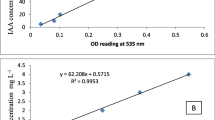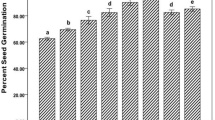Abstract
The present study was done to isolate and characterize two strains of phosphate solubilizing bacteria from rhizospheres of acacia, sugar beet, and wheat, then determine synergic effects of nanosilica and these strains on the vegetative growth of land cress plant. Isolates identification was performed using physiological, morphological, biochemical tests, and 16S ribosomal ribonucleic acid sequencing. Nanosilica was extracted from Equisetum telmateia and characterized via X-ray diffraction, scanning electron microscopy, dynamic light scattering, Brunauer–Emmett–Teller, and X-ray fluorescence techniques. The size and the purity of extracted silica powder were about 30 nm, 97.5 %, respectively. Two strains, namely, Pseudomonas stutzeri and Mesorhizobium sp. were the most efficient strains to grow and solubilize phosphorus in the presence of 860 mM NaCl and various pH conditions. The highest growth of these two strains was observed at 0.05 and 0.07 ppm of nanosilica. The highest amount of dry weight of shoot and root of land cress plant was recorded with the simultaneous application of these strains in combination with nanosilica. The combination of nanosilica and these strains enhanced the soil nitrogen and phosphorus content and the vegetative growth of land cress plant.








Similar content being viewed by others
References
Adesemoye A, Torbert H, Kloepper J (2009) Plant growth-promoting rhizobacteria allow reduced application rates of chemical fertilizers. Microbial ecology 58:921–929
Al-Garni SM, Khan MMA, Bahieldin A (2019) Plant growth-promoting bacteria and silicon fertilizer enhance plant growth and salinity tolerance in Coriandrum sativum. Journal of Plant Interactions 14:386–396
Ali S, Rizwan M, Hussain A, ur Rehman MZ, Ali B, Yousaf B, Wijaya L, Alyemeni MN, Ahmad P (2019) Silicon nanoparticles enhanced the growth and reduced the cadmium accumulation in grains of wheat (Triticum aestivum L.). Plant Physiology and Biochemistry 140:1–8
Alsaeedi A, El-Ramady H, Alshaal T, El-Garawani M, Elhawat N, Al-Otaibi A (2018) Exogenous nanosilica improves germination and growth of cucumber by maintaining K+/Na+ ratio under elevated Na+ stress. Plant physiology and biochemistry 125:164–171
Amardip S, Ghosh A (2011) Characterization, identification & cataloguing of agriculturally important microorganisms isolated from selected wetland and rain-fed ecosystem of Bihar. Asian Journal of Experimental Biological Sciences 2:575–582
Assefi M, Davar F, Hadadzadeh H (2015) Green synthesis of nanosilica by thermal decomposition of pine cones and pine needles. Advanced Powder Technology 26:1583–1589
Basile-Doelsch I, Meunier JD, Parron C (2005) Another continental pool in the terrestrial silicon cycle. Nature 433:399–402
Behbahani M (2011) Investigation of biological behavior and colonization ability of Iranian indigenous phosphate solubilizing bacteria. Scientia horticulturae 124:393–399
Bhat SA, Singh J, Vig AP (2018) Earthworms as organic waste managers and biofertilizer producers. Waste and Biomass Valorization 9:1073–1086
Bhattacharyya PN, Jha DK (2012) Plant growth-promoting rhizobacteria (PGPR): emergence in agriculture. World Journal of Microbiology and Biotechnology 28:1327–1350
BLAST. http://www.ncbi.nlm.nih.gov. 2019
Carneiro, M. (2012) Obtaining nano silica from Equisetum arvenses L and their use in the modification of veneers of schizolobium parahyba var. amazonicum (Huber ex Ducke) wood, Ph. D. thesis, Federal University of Parana, Curitiba, Brazil (in Portuguese).
Carneiro ME, Magalhães WL, BOLZON DE MUÑIZ, G., Nisgoski, S., and Satyanarayana, K. G. (2015) Preparation and characterization of nano silica from Equisetum arvenses. Embrapa Florestas-Artigo em periódico indexado (ALICE).
Deshmukh RK, Ma JF, Bélanger RR (2017) Role of silicon in plants. Frontiers Media, Lausanne
Farouk S, Al-Sanoussi AJ (2019) The role of biostimulants in increasing barley plant growth and yield under newly cultivated sandy soil. Cercetări Agronomice în Moldova (Agronomical Research in Moldavia) LII(178):114-125. https://doi.org/10.2478/cerce-2019-0012.
Farouk S, EL-Metwally IM (2019) Synergistic responses of drip-irrigated wheat crop to chitosan and/or silicon under different irrigation regimes. Agricultural Water Management 226:105807. https://doi.org/10.1016/j.agwat.2019.105807
Freitas JC, Emmerich FG, Bonagamba TJ (2000) High-resolution solid-state NMR study of the occurrence and thermal transformations of silicon-containing species in biomass materials. Chemistry of materials 12:711–718
Goes K, de Castro Fisher ML, Cattelan AJ, Nogueira MA, Portela de Carvalho CG, Martinez de Oliveira AL (2012) Biochemical and molecular characterization of high population density bacteria isolated from sunflower. J. Microbiol. Biotechnol 22:437–447
Gulati A, Sharma N, Vyas P, Sood S, Rahi P, Pathania V, Prasad R (2010) Organic acid production and plant growth promotion as a function of phosphate solubilization by Acinetobacter rhizosphaerae strain BIHB 723 isolated from the cold deserts of the trans-Himalayas. Archives of microbiology 192:975–983
Haile, D., Mekbib, F., and Assefa, F. (2016) Isolation of phosphate solubilizing bacteria from white lupin (Lupinus albus L.) rhizosphere soils collected from Gojam, Ethiopia, J Fertil Pestic 7, 2.
Haynes RJ (2014) A contemporary overview of silicon availability in agricultural soils. J. Soil Sci. Plant Nutr 177:831–844
Hu X, Chen J, Guo J (2006) Two phosphate-and potassium-solubilizing bacteria isolated from Tianmu Mountain. Zhejiang, China, World journal of Microbiology and Biotechnology 22:983–990
Iavicoli I, Leso V, Beezhold DH, Shvedova AA (2017) Nanotechnology in agriculture: opportunities, toxicological implications, and occupational risks. Toxicol Appl Pharmacol 329:96–111
Kalteh M, Alipour ZT, Ashraf S, Marashi Aliabadi M, Falah Nosratabadi A (2018) Effect of silica nanoparticles on basil (Ocimum basilicum) under salinity stress. Journal of Chemical Health Risks 4
Karunakaran G, Suriyaprabha R, Manivasakan P, Yuvakkumar R, Rajendran V, Prabu P, Kannan N (2013) Effect of nanosilica and silicon sources on plant growth promoting rhizobacteria, soil nutrients and maize seed germination. IET nanobiotechnology 7:70–77
Khan, M. S., Zaidi, A., and Ahmad, E. (2014) Mechanism of phosphate solubilization and physiological functions of phosphate-solubilizing microorganisms, In Phosphate solubilizing microorganisms, pp 31-62, Springer.
Kochian LV (2012) Plant nutrition: rooting for more phosphorus. Nature 488:466
Kumar V, Narula N (1999) Solubilization of inorganic phosphates and growth emergence of wheat as affected by Azotobacter chroococcum mutants. Biology and Fertility of Soils 28:301–305
Liang Y, Nikolic M, Bélanger R, Gong H, Song A (2015) Silicon in agriculture. Springer, Dordrecht
Liou T-H, Wu S-J (2010) Kinetics study and characteristics of silica nanoparticles produced from biomass-based material. Industrial & Engineering Chemistry Research 49:8379–8387
Lu G, Moriyama EN (2004) Vector NTI, a balanced all-in-one sequence analysis suite. Briefings in bioinformatics 5:378–388
Ma Y, Rajkumar M, Freitas H (2009) Inoculation of plant growth promoting bacterium Achromobacter xylosoxidans strain Ax10 for the improvement of copper phytoextraction by Brassica juncea. Journal of Environmental Management 90:831–837
Majeed A, Abbasi MK, Hameed S, Imran A, Rahim N (2015) Isolation and characterization of plant growth-promoting rhizobacteria from wheat rhizosphere and their effect on plant growth promotion. Frontiers in microbiology 6:198
Mao D-P, Zhou Q, Chen C-Y, Quan Z-X (2012) Coverage evaluation of universal bacterial primers using the metagenomic datasets. BMC microbiology 12:66
Mittal AK, Chisti Y, Banerjee UC (2013) Synthesis of metallic nanoparticles using plant extracts. Biotechnology advances 31:346–356
Moore E, Arnscheidt A, Krüger A, Strömpl C, Mau M (1999) Simplified protocols for the preparation of genomic DNA from bacterial cultures. Molecular microbial ecology manual 1:1–15
Nautiyal CS, Bhadauria S, Kumar P, Lal H, Mondal R, Verma D (2000) Stress induced phosphate solubilization in bacteria isolated from alkaline soils. FEMS Microbiology Letters 182:291–296
Pande A, Pandey P, Mehra S, Singh M, Kaushik S (2017) Phenotypic and genotypic characterization of phosphate solubilizing bacteria and their efficiency on the growth of maize. Journal of Genetic Engineering and Biotechnology 15:379–391
Park KH, Lee CY, Son HJ (2009) Mechanism of insoluble phosphate solubilization by Pseudomonas fluorescens RAF15 isolated from ginseng rhizosphere and its plant growth-promoting activities. Letters in applied microbiology 49:222–228
Perrig D, Boiero M, Masciarelli O, Penna C, Ruiz O, Cassán F, Luna M (2007) Plant-growth-promoting compounds produced by two agronomically important strains of Azospirillum brasilense, and implications for inoculant formulation. Applied microbiology and biotechnology 75:1143–1150
Rangaraj S, Gopalu K, Muthusamy P, Rathinam Y, Venkatachalam R, Narayanasamy K (2014) Augmented biocontrol action of silica nanoparticles and Pseudomonas fluorescens bioformulant in maize (Zea mays L.). RSC Advances 4:8461–8465
Rastogi A, Tripathi DK, Yadav S, Chauhan DK, Živčák M, Ghorbanpour M, El-Sheery NI, Brestic M (2019) Application of silicon nanoparticles in agriculture. 3. Biotech 9:90
Richardson AE (2001) Prospects for using soil microorganisms to improve the acquisition of phosphorus by plants. Functional Plant Biology 28:897–906
Rizwan M, Ali S, Qayyum MF, Ok YS, Adrees M, Ibrahim M, Rehman MZ, Farid M, Abbas F (2017) Effect of metal and metal oxide nanoparticles on growth and physiology of globally important food crops: a critical review. J Hazard Mater 322:2–16
Rodríguez H, Fraga R (1999) Phosphate solubilizing bacteria and their role in plant growth promotion. Biotechnology advances 17:319–339
Rodríguez H, Rossolini GM, Gonzalez T, Li J, Glick BR (2000) Isolation of a gene from Burkholderia cepacia IS-16 encoding a protein that facilitates phosphatase activity. Current microbiology 40:362–366
Saharan B, Nehra V (2011) Plant growth promoting rhizobacteria: a critical review. Life Sci Med Res 21:30
Sahebi M, Hanafi MM, Siti Nor Akmar A, Rafii MY, Azizi P, Tengoua FF, Nurul Mayzaitul Azwa J, Shabanimofrad M (2015) Importance of silicon and mechanisms of biosilica formation in plants. BioMed research international 2015:396010
Sharma SB, Sayyed RZ, Trivedi MH, Gobi TA (2013) Phosphate solubilizing microbes: sustainable approach for managing phosphorus deficiency in agricultural soils. SpringerPlus 2:587
Siddiqui MH, Al-Whaibi MH (2014) Role of nano-SiO2 in germination of tomato (Lycopersicum esculentum seeds Mill.). Saudi journal of biological sciences 21:13–17
Sun D, Hussain HI, Yi Z, Rookes JE, Kong L, Cahill DM (2016) Mesoporous silica nanoparticles enhance seedling growth and photosynthesis in wheat and lupin. Chemosphere 152:81–91
Tripathi DK, Singh S, Singh VP, Prasad SM, Dubey NK, Chauhan DK (2016) Silicon nanoparticles more effectively alleviated UV-B stress than silicon in wheat (Triticum aestivum) seedlings. Plant Physiol Biochem 110:70–80
Tubana BS, Babu T, Datnoff LE (2016) A review of silicon in soils and plants and its role in US agriculture: history and future perspectives. Soil Sci 181:393–411
Vassilev N, Medina A, Azcon R, Vassileva M (2006) Microbial solubilization of rock phosphate on media containing agro-industrial wastes and effect of the resulting products on plant growth and P uptake. Plant and Soil 287:77
Vazquez P, Holguin G, Puente M, Lopez-Cortes A, Bashan Y (2000) Phosphate-solubilizing microorganisms associated with the rhizosphere of mangroves in a semiarid coastal lagoon. Biology and Fertility of Soils 30:460–468
Vessey JK (2003) Plant growth promoting rhizobacteria as biofertilizers. Plant and soil 255:571–586
Watanabe F, Olsen S (1965) Test of an ascorbic acid method for determining phosphorus in water and NaHCO3 extracts from soil 1. Soil Science Society of America Journal 29:677–678
Yu X, Liu X, Zhu TH, Liu GH, Mao C (2011) Isolation and characterization of phosphate-solubilizing bacteria from walnut and their effect on growth and phosphorus mobilization. Biology and Fertility of Soils 47:437–446
Zhu, F., Qu, L., Hong, X., and Sun, X. (2011) Isolation and characterization of a phosphate-solubilizing halophilic bacterium Kushneria sp. YCWA18 from Daqiao Saltern on the coast of Yellow Sea of China, Evidence-Based Complementary and Alternative Medicine 2011.
Acknowledgment
The authors appreciate the financial support of this investigation by the research council of the University of Isfahan.
Author information
Authors and Affiliations
Corresponding author
Ethics declarations
Conflict of Interest
The authors declare that they have no conflict of interest.
Additional information
Publisher’s note
Springer Nature remains neutral with regard to jurisdictional claims in published maps and institutional affiliations.
Rights and permissions
About this article
Cite this article
Boroumand, N., Behbahani, M. & Dini, G. Combined Effects of Phosphate Solubilizing Bacteria and Nanosilica on the Growth of Land Cress Plant. J Soil Sci Plant Nutr 20, 232–243 (2020). https://doi.org/10.1007/s42729-019-00126-8
Received:
Accepted:
Published:
Issue Date:
DOI: https://doi.org/10.1007/s42729-019-00126-8




